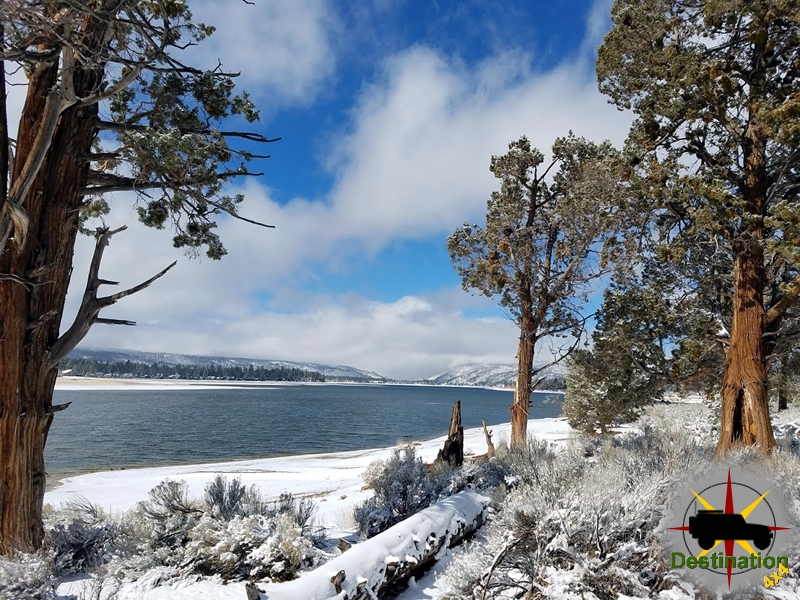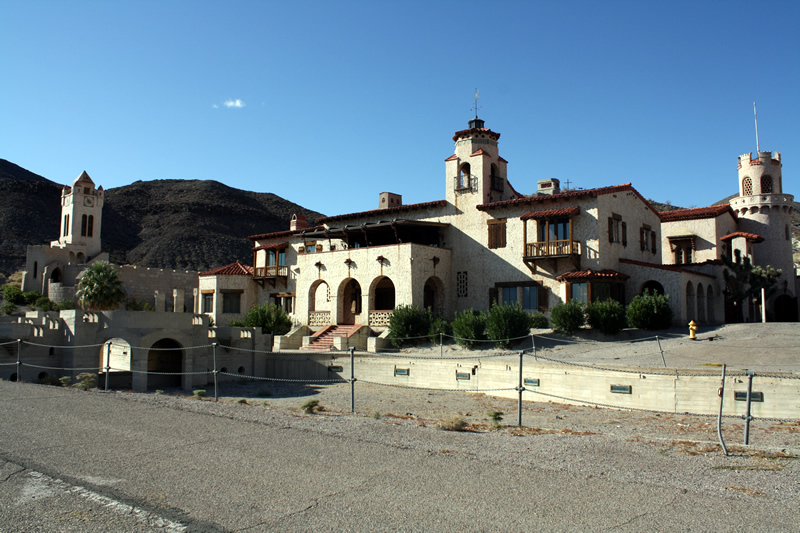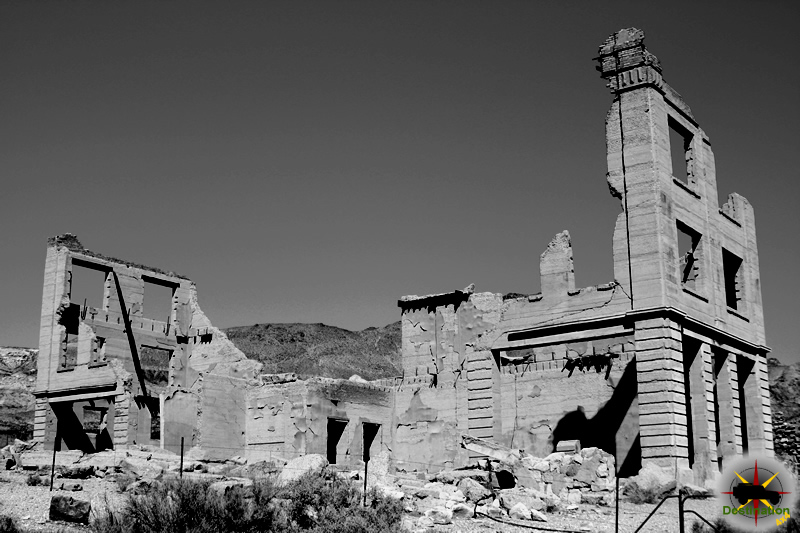
Gold Mountain Mine – Gold Fever Trail
Located about 10.8 miles from the start of the Gold Fever Off Road Trail, the Gold Mountain mine is an abandoned mine site which overlooks the town site of Doble and Baldwin Lake.

The mine, also known as the “Lucky Baldwin” Mine was the last major gold discovery in the area. In 1873, Barney and Charley Carter were en route to the Rose Mine, when they camped along the north shore of Baldwin Lake. During this trip, Barney climbed the hill to investigate some “shiny stuff” observed from their camp. This “shiny stuff” proved to be a quartz ledge which is rich in gold ore. They Carter Brothers sold their claim, “Carters Quartz Hill” to Elias J. “Lucky” Baldwin for the sum on $30,000.00.

Making his own luck, Baldwin had 180 men working the site and running a 40-stamp mill by 1876. The concrete foundations for this mill are visible just to the west of the mine headframe. The mill is operated up until 1923.
In 1875, William F Holcomb returned to the valley, it is said from curiosity and sentimentality. His return allowed him to witness the collapse of the mining camps. Following the collapse, the gold rush started by Holcomb in 1860 became the largest gold rush in Southern California
Mine Summary
| Name | Gold Mountain Mine |
| Also known as | Lucky Baldwin Mine, Carters Quartz Hill |
| Location | San Bernardino County, California |
| Latitude, Longitude | 34.3026, -116.8291 |
| Gold Fever Off Road Trail Marker No. | 12 |
Gold Mountain Trail Map
Gold Fever Off Road Trail
The Gold Fever Off Road Trail is a back country drive by some historical sites in Holcomb Valley, in the San Bernardino Mountains. The trail departs highway 38 along the western edge of Big Bear Lake, near the discovery center.

The trail departs highway 38 along the western edge of Big Bear Lake, near the discovery center. The route follows Polique Canyon Road up the a junction with 3N16 near the Holcomb Valley Ranch. Climbing up about 3.9 miles along Polique Canyon Road, you will pass the first two of ten sites, which are the Holcomb Valley View and Last Chance Placer.
From Last Chance Placer, the trail turns east on to the Holcomb Valley Road, 3N16. Following 3N16 for about one half mile, the trail insects and turns to the left on to Gold Fever Road. Gold Fever Road is a quick side trail from 3N16 and allows access to Two Gun Bills Saloon, Grasshopper Quartz Mill and the Hangman’s Tree. Gold Fever Road again connects to the Holcomb Valley Road and quickly the sites of the Original Gold Diggings, Bellville and Arrastres come into view situated around a large meadow.
From the Bellville townsite, the trail winds around Gold Mountain and drops back down to Big Bear near Baldwin lake. This last leg of the trail brings the sites of Ross’s Grave, Pygmy Cabin, Metzger Mine and Lucky Baldwin Mine into play.
Overall, the gentle tail offers probably the best one day tour of Holcomb Valley. The tour is well defined and markers along the way offer history lessons for the explorer. Our biggest issue with the route, is that two of the locations are not the actual locations that supposed events happened. For example, Two Gun Bill’s Saloon is just an old large cabin site. The actual location of the Saloon is the the southeast corner of 3N16 and 3N12. The could have added this actual site along the route and kept the current site as a large cabin site.
Trail Markers
| 1 | Holcomb View Trail | 3.2 Miles |
| 2 | Last Chance Placer | 4.8 Miles |
| 3 | Two Gun Bill’s Saloon | 5.8 Miles |
| 4 | Jonathon Tibbets’ Grasshopper Quartz Mill | 6.3 Miles |
| 5 | Hangman’s Tree | 6.5 Miles |
| 6 | Original Gold Diggings | 6.8 Miles |
| 7 | Belleville | 7.1 Miles |
| 8 | Arrastres (Gold Ore Grinders) | 7.1 Miles |
| 9 | Ross’ Grave | 7.3 Miles |
| 10 | Pygmy Cabin Site | 7.3 Miles |
| 11 | Metzger Mines | 9.0 Miles |
| 12 | Gold Mountain also known as “Lucky Baldwin” Mine | 10.8 Miles |
Trail Summary
| Name | Gold Fever Off Road Trail |
| Location | Big Bear, Holcomb Valley San Bernardino Mountains, California |
| Latitude, Longitude | 34.2662, -116.9205 |
| Difficulty | Easy, pending conditions |
| Length | 11.5 Miles |
Gold Fever Off Road Trail Map
Points of Interest
 Arrastres – Gold Fever TrailThe Arrastres is a point of interest found along the Gold Fever Off Road Trail in Holcomb Valley in the San Bernardino Mountains. The remains… |
 Belleville California – San Bernardino County Ghost TownThe cabin at the Belleville California townsite is not original but moved to the location to represent the style of the structures of the town.… |
 Gold Mountain Mine – Gold Fever TrailLocated about 10.8 miles from the start of the Gold Fever Off Road Trail, the Gold Mountain mine is an abandoned mine site which overlooks… |
 Hangman’s Tree – Gold Fever TrailThe Hangman’s Tree is a point of interest found along the Gold Fever Off Road Trail in Holcomb Valley in the San Bernardino Mountains. The… |
 Jonathon Tibbets Grasshopper Quartz MillStop number four along the Gold Fever Off Road Trail is Holcomb Valley, is Jonathon Tibbets Grasshopper Quartz Mill. The Gold Fever Off Road Trail… |
 Two Gun Bill’s SaloonLocated at stop 3 along the Gold Fever Off Road trail is the supposed location of Two Gun Bill's Saloon in Holcomb Valley, California. The… |
Hangman’s Tree – Gold Fever Trail
The Hangman’s Tree is a point of interest found along the Gold Fever Off Road Trail in Holcomb Valley in the San Bernardino Mountains.

As miners and prospectors came to seek their fortune, outlaws, claim jumpers, gamblers and other trouble makes followed close behind. In late August, 1861, Holcomb valley is overrun by a group of organized horse thieves from Salt Lake City. The group, known as the Button’s Gang take over was so complete, the simply took over any cabin or settlement and appropriated any supplies and equipment within.
In the first two years since the discovery of Holcomb valley, over 50 murders are committed in the area. “Hell Roaring Johnson” is shot and killed for trying to fix the first election to be hold in the valley. Some outlaws evaded justice, but those not as fortunate found their reward at the Hangman’s Tree.
The tree labelled as the “Hangmans Tree” is not the original tree used in the 1800’s. However, it is commonly mistaken for the famous tree from Holcomb’s history. The remains of the original tree is believed to be located where a stump exists about 100 feet east of the Bellville Cabin.
Point of Interest Summary
| Name | Hangman’s Tree |
| Location | Holcomb Valley, San Bernardino County, California |
| Latitude, Longitude | 34.3034, -116.8891 |
| Gold Fever Trail Marker | 5 |
Hangman’s Tree Trail Map
Arrastres – Gold Fever Trail
The Arrastres is a point of interest found along the Gold Fever Off Road Trail in Holcomb Valley in the San Bernardino Mountains.

The device is the oldest tool for recovering gold from rock and employed by Mexican miners. The device consists of a low concrete wall surrounding a level flat concrete floor. In the center is a post around which a horizonal beam and pulled by a mule or donkey. Hanging from the beam using chain would be a large boulder which would pulverize gold ore, facilitating gold extraction. This is a very slow process and inefficient process and the team would circle the site for hours while the heavy boulder performed its task. A single pile of ore could take four hours to process.
The Arrastres site in Holcomb Valley is a wonderful example of early gold mining technology locate en situ near the Bellville Townsite. The site is a very short hike (150 feet ) from the one remaining building at the site and well worth the walk. At tone time, it is estimate that over 100 arrastres located within Holbcomb Valley.
Point of Interest Summary
| Name | Arrastres – Point of Interest |
| Location | Gold Fever Off Road Trail, Holcomb Valley San Bernardino County, California |
| Latitude, Longitude | 34.3014, -116.8863 |
| Gold Fever Trail Marker | 8 |
Arrastres Trail Map
Resources
Deposition of Wesley Fuller in the Preliminary Hearing in the Earp-Holliday Case
The Gunfight at the O.K. Corral, one of the most famous shootouts in the American Old West, took place on October 26, 1881, in Tombstone, Arizona Territory. The confrontation involved lawmen Virgil, Wyatt, and Morgan Earp, along with Doc Holliday, against the outlaw Cochise County Cowboys, including Ike and Billy Clanton, Tom McLaury, and Frank McLaury. Tensions had been building for months between the Earps and the Cowboys, stemming from political differences, law enforcement disputes, and personal grudges. The actual gunfight lasted only about 30 seconds, with the Earps and Holliday emerging victorious, killing Tom and Frank McLaury and Billy Clanton.

Although the gunfight was relatively brief and took place in a small alley near the O.K. Corral, its impact on American folklore and the mythos of the Wild West has been significant. The shootout was later romanticized in literature, film, and popular culture, often portraying the Earps and Holliday as heroic figures standing up against lawlessness. However, the events leading up to and following the gunfight were complex, involving legal battles, public opinion, and ongoing violence, reflecting the broader conflicts of power and law in the tumultuous frontier society.
Testimony
On this seventh day of November, 1881, on the hearing of the above entitled cause of the examination of Wyatt Earp and J. H. Holliday; Wesley Fuller, a witness of lawful age, being produced and sworn, says as follows:
Deposition of Wesley Fuller, a gambler, of Tombstone. He states he saw the difficulty between the Earps and Holliday on one side and the McLaury brothers and the Clantons on the other, on Fremont, near the comer of Third Street. He was right back of Fly’s Gallery in the alley when the shooting began. He says he saw the Earp party, armed, at Fourth and Allen and that he was on his way to warn Billy Clanton to get out of town. He saw Billy, Frank McLaury and he thinks Behan, but did not gel to speak with Billy, as just then the Earps hove into view, and he heard them say, “Throw up your hands!” Billy Clanton threw up his hands and said, “Don’t shoot me! I don’t want to fight!” and at the same time the shooting commenced. At this time, he had not seen Tom McLaury nor Ike Clanton.
He says the Earp party fired the first shots. Two were fired right away, they were fired almost together. They commenced firing then very rapidly and fired 20 or 30 shots. Both sides were firing. Five or six shots were fired by the Earp party before the other party fired. Billy Clanton and Frank McLaury were the only two I saw fire of the Clanton party. As the first shots were fired by the Earp party, Billy Clanton had his hands up. [Shows the position as he stood raising his hands up to the line of his head.] Frank McLaury was standing, holding his horse when the firing commenced. He was not doing anything that I could see. He had no weapon that I saw on him. I saw his hands and he had nothing in them. If there had been, I would have seen it. I think the first two shots were aimed at Billy Clanton. I saw that he was hit. He threw his hands on his belly and wheeled around. I did not see any effect on anybody else at that time. Frank McLaury drew a weapon and was firing during [illegible]. When he drew his weapon, he was on Fremont Street, a little past the middle of the Street. [Shows on diagram.] Further talk as to relative positions. Then he says, on questions, that seven or eight shots had been fired by the Earp party before he saw Frank McLaury draw his pistol. He tells of the space between Fly’s and other building, and says he saw Tom McLaury there. He did not see Tom again until they brought him into the building. He does not know where Ike went after seeing him pass through this building. He says Tom was staggering, as though he was hurt. He did not see any arms or even a cartridge belt on Tom after he had been brought into the building where he died. He never saw Ike with any arms at the scene of the battle. He tells of seeing Billy rolling around on the ground in agony. He helped take him into the building. He says Billy said to him, “Look and see where I am shot.” He looked. He tells of wound in belly and other near left nipple. He says he told Billy he could not live. Billy said, “Get a doctor and give me something to put me to sleep.” He says this is all he recollects; that he did not leave until Billy died.
He says he saw Billy shooting during the fight, a pistol; that he was then in a crouching position, sliding down against the comer of the house. He had drawn his pistol with his left hand. He says six or seven shots had been fired by the Earps before Billy drew his pistol. He says Billy was shot in the right wrist. When he saw Frank in the middle of the street, drawing his pistol he was staggering then appeared to be wounded, acted dizzy. He says Billy and Frank each had a horse there and he thinks each had a rifle strapped on in a scabbard. He is sure this was true of Frank’s horse. More talk about the rifle on Frank’s horse. He tells of Frank leaving the horse in about the middle of the street and staggering up the street. He says previously it seemed as if Frank was trying to get the rifle out of the scabbard, but the horse kept jumping away from [him]; “He was fooling with the horse.” He says probably seven or eight shots had been fired by the Earp party, “probably more,” before Frank commenced trying to get the rifle.
CROSS EXAMINATION
He states he was on Allen Street between Third and Fourth Streets, on the north side, just below the O.K. Corral, when he first saw Billy Clanton, Frank McLaury and Johnny Behan on Fremont. He relates of seeing Holliday put a six-shooter in his coat pocket at Fourth and Allen. Saw one in Morgan Earp’s pocket, on the right side. Wyatt had one pushed down in his pants on the right side a little. I was standing on the comer of Fourth and Allen Streets, I mean not far from them, about ten or twelve feet. I do not recollect what kind of a coat Wyatt Earp had on-at times the pistol was under his coat. I do not recollect whether Wyatt Earp had on an overcoat or not. When I saw the pistol, his coat was not buttoned. Virgil Earp had a shotgun.
He says he went right down Allen Street after seeing the Earps on the comer of Fourth and Allen, and “walked along not very fast. I stopped, probably four or five seconds and spoke a few words as I was going to this vacant space; I spoke to Mattie Webb. It was at the rear of her house that I spoke to her.,,3 He says he was not there when the first shot was fired. He shows on diagram how he went. He says he stayed in the alley but moved around during the shooting, “as bullets were flying around there.” He says he kept stepping backwards, but kept his face towards Fremont and the shooting. He locates the position of the various combatants on the diagram.
He goes on to say he thinks Morgan Earp and Doc Holliday fired the first two shots, but can’t tell which fired first. He says they were fired at Billy Clanton. He saw them shoot. He reiterates this. He denies he was excited. He denies he had been drinking during the day. On question says it was about 3:00 A.M. when he went to bed, and got up between 11 and 12, “I should judge.”
He admits he had been drinking the day or evening before the fight, considerable; indicates it was over a period of several days. He denies he had a fit of delirium tremens. He describes the character of the wound on Billy Clanton’s wrist by pointing to Mr. Fitch’s wrist, a point about three inches from the palm of the hand and says, “I think it was about there. I don’t know whether it was on the inside or outside of the arm.” He doesn’t know if it was on both sides, or deep, or shallow, and did not see any bullet in the hole, and doesn’t know the extent of the wound. He doesn’t believe Frank fired before he became separated from his horse. He is sure he saw Ike Clanton pass through the vacant space between Fly’s buildings and that Tom McLaury also staggered into the same area. He admits he knows William Allen, but doesn’t know if he is one of those who brought Tom McLaury into the house-“The house on the comer of Third and Fremont, the second house below Fly’s Gallery.” He reiterated that Billy was rolling around on the ground, and doesn’t know what became of his horse. He says Billy and his horse became separated immediately after the fight began and he did not see the horse again. He can’t place the horses on the diagram.
(Q) What are your feelings toward the defendant Holliday?
(A) We have always been good friends, and are so now.
(Q) Did you not, on the fifth day of November, 1881, about 5 o’clock in the afternoon, in front of the Oriental Saloon in Tombstone, say to or in the presence of Wyatt Earp, that you knew nothing in your testimony that would hurt the Earps, but that you intended to cinch Holliday, or words of like import or effect?
(A) I told Wyatt Earp then that I thought Holliday was the cause of the fight, I don’t say positively I might have used words, “I mean to cinch Holliday,” but I don’t think I did.
RE-DIRECT EXAMINATION
(Q) At the time you referred to, that you had the conversation with Wyatt Earp in the last interrogation, who was present, if anyone?
(A) There were parties there, but I don’t remember who they were.
(Q) Who were you talking to?
(A) Wyatt Earp.
[Signed] Wesley Fuller



